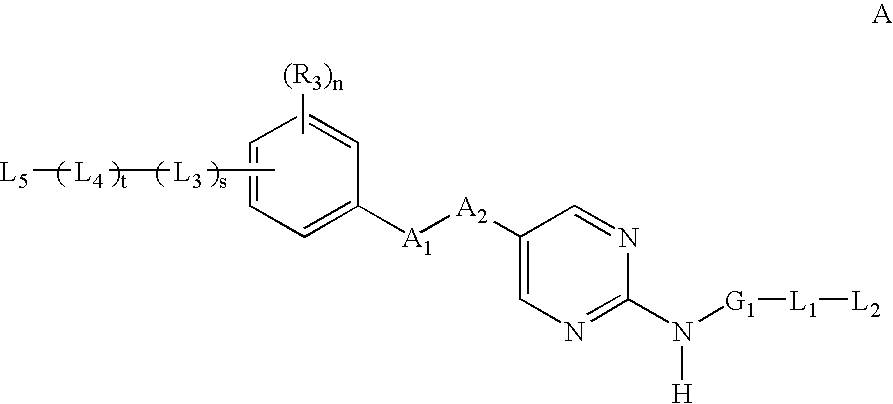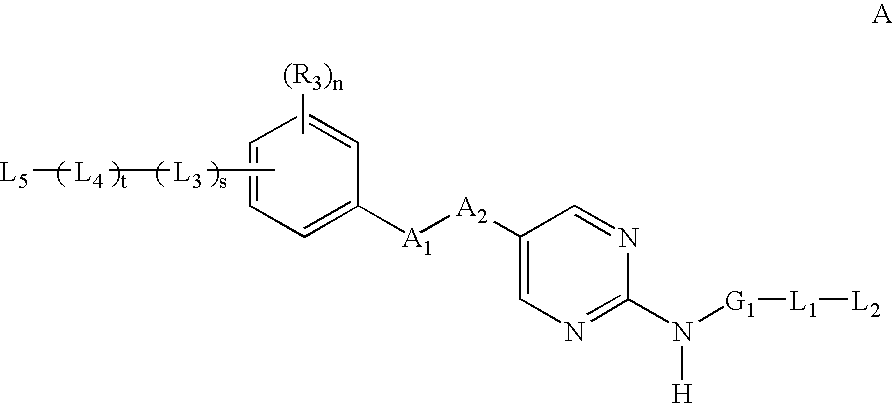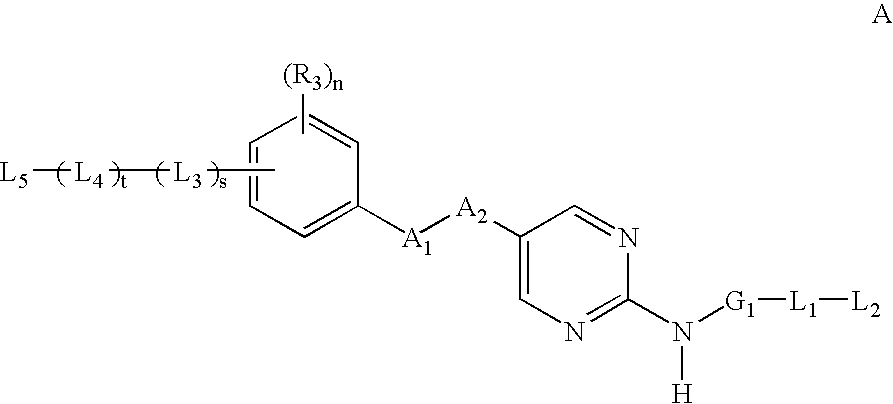2-amino--5-substituted pyrimidine inhibitors
a technology of pyrimidine and amino-amino-5, which is applied in the field of pyrimidine-based compounds, can solve the problems of reduced vascular leakage, reduced signaling network function, and extensive cross-talk
- Summary
- Abstract
- Description
- Claims
- Application Information
AI Technical Summary
Benefits of technology
Problems solved by technology
Method used
Image
Examples
example 1
General Methods
[0125] All experiments were performed under anhydrous conditions (i.e. dry solvents) in an atmosphere of argon, except where stated, using oven-dried apparatus and employing standard techniques in handling air-sensitive materials. Aqueous solutions of sodium bicarbonate (NaHCO3) and sodium chloride (brine) were saturated. Analytical thin layer chromatography (TLC) was carried out on Merck Kieselgel 60 F254 plates with visualization by ultraviolet and / or anisaldehyde, potassium permanganate or phosphomolybdic acid dips. Reverse-phase HPLC chromatography was carried out on Gilson 215 liquid handler equipped with Waters SymmetryShield™ RP 18 7 μm (40×100 mm) Prep-Pak cartridge. Mobile phase consisted of standard acetonitrile (ACN) and DI Water, each with 0.1% TFA added. Purification was carried out at a flow rate of 40 mL / min. NMR spectra: 1H Nuclear magnetic resonance spectra were recorded at 500 MHz. Data are presented as follows: chemical shift, multiplicity (s=singl...
example 2
Synthesis of 5-(3-(Trifluoromethyl)Benzamido)-2-Chlorobenzoic Acid (Intermediate 1)
[0126]
[0127] To a stirring solution of 5-amino-2-chlorobenzoic acid (1.74 g, 10.1 mmol) in anhydrous THF (60 mL), 3-(trifluoromethyl)benzoyl chloride (2.33 g, 11.2 mmol) was added slowly. The mixture was stirred at room temperature under argon for overnight. The solvent was removed under reduced pressure and re-crystallized from acetone / chloroform (v / v 1:1) to afford the title compound as a white solid (1.5 g, 43%).
[0128]1H NMR (500 MHz, DMSO-d6): δ 7.55 (d, J=8.8 Hz, 1H), 7.80 (t, J=7.8 Hz, 1H), 7.99 (dd, J=8.7 Hz, J=2.5 Hz, 2H), 8.15-8.35 (m, 2H), 8.32 (s, 1H), 10.69 (s, 1H), 13.47 (br s, 1H).
example 3
Synthesis of N-[4-(3-Pyrrolidin-1-yl-Propane-1-Sulfonyl)-Phenyl]-Pyrimidine-2,5-Diamine (Intermediate 2)
[0129]
[0130] To a solution of 2-amino-5-nitropyrimidine (840 mg, 6.0 mmol) in 50 mL anhydrous 1,4-dioxane were added 1-[3-(4-bromo-benzenesulfonyl)-propyl]-pyrrolidine (2.9 g, 8.7 mmol), Xantphos, (690 mg, 1.2 mmol), Pd2(dba)3 (559 mg, 0.61 mmol) and Cs2CO3 (5.8 g, 18 mmol). The reaction mixture was stirred at 100° C. for 5 h under argon. The solvent was removed under reduced pressure. The resulting solution was extracted with CHCl3 (3×50 mL) and sat. NaHCO3 (50 mL). The organic layer was separated, washed with brine, dried over Na2SO4 and filtered. The organic solvent was removed and the crude product was purified by silica gel column with 20% CH3OH / CHCl3 as an eluent. The precipitated yellow solid was isolated by washed with acetone and dried in vacuo (1.2 g, 52%). The above product was hydrogenated in 100 mL methanol / ethyl acetate (v / v: 1:1) using Pd / C (10%, 1 g) for 2 h. The ...
PUM
| Property | Measurement | Unit |
|---|---|---|
| flow rate | aaaaa | aaaaa |
| v/v | aaaaa | aaaaa |
| temperature | aaaaa | aaaaa |
Abstract
Description
Claims
Application Information
 Login to View More
Login to View More - R&D
- Intellectual Property
- Life Sciences
- Materials
- Tech Scout
- Unparalleled Data Quality
- Higher Quality Content
- 60% Fewer Hallucinations
Browse by: Latest US Patents, China's latest patents, Technical Efficacy Thesaurus, Application Domain, Technology Topic, Popular Technical Reports.
© 2025 PatSnap. All rights reserved.Legal|Privacy policy|Modern Slavery Act Transparency Statement|Sitemap|About US| Contact US: help@patsnap.com



